[English] 日本語
 Yorodumi
Yorodumi- PDB-8b82: Crystal structure of Scribble PDZ1 with human papillomavirus stra... -
+ Open data
Open data
- Basic information
Basic information
| Entry | Database: PDB / ID: 8b82 | |||||||||
|---|---|---|---|---|---|---|---|---|---|---|
| Title | Crystal structure of Scribble PDZ1 with human papillomavirus strain 16 E6 peptide | |||||||||
 Components Components |
| |||||||||
 Keywords Keywords | PROTEIN BINDING / Scribble / human papillomavirus / E6 / PDZ domain / cell polarity | |||||||||
| Function / homology |  Function and homology information Function and homology informationextrinsic component of postsynaptic density membrane / establishment of T cell polarity / symbiont-mediated perturbation of host apoptosis / cochlear nucleus development / apoptotic process involved in morphogenesis / astrocyte cell migration / myelin sheath abaxonal region / Scrib-APC-beta-catenin complex / establishment of apical/basal cell polarity / polarized epithelial cell differentiation ...extrinsic component of postsynaptic density membrane / establishment of T cell polarity / symbiont-mediated perturbation of host apoptosis / cochlear nucleus development / apoptotic process involved in morphogenesis / astrocyte cell migration / myelin sheath abaxonal region / Scrib-APC-beta-catenin complex / establishment of apical/basal cell polarity / polarized epithelial cell differentiation / synaptic vesicle targeting / epithelial structure maintenance / neurotransmitter receptor transport, endosome to postsynaptic membrane / mammary gland duct morphogenesis / cell-cell contact zone / post-anal tail morphogenesis / establishment or maintenance of epithelial cell apical/basal polarity / activation of GTPase activity / protein localization to adherens junction / auditory receptor cell stereocilium organization / negative regulation of mitotic cell cycle / RND2 GTPase cycle / RND3 GTPase cycle / positive chemotaxis / regulation of postsynaptic neurotransmitter receptor internalization / receptor clustering / negative regulation of activated T cell proliferation / RHOJ GTPase cycle / RHOQ GTPase cycle / positive regulation of receptor recycling / CDC42 GTPase cycle / immunological synapse / synaptic vesicle endocytosis / signaling adaptor activity / Asymmetric localization of PCP proteins / neural tube closure / adherens junction / PDZ domain binding / wound healing / cell-cell adhesion / positive regulation of type II interferon production / cell-cell junction / cell junction / cell migration / presynapse / lamellipodium / symbiont-mediated suppression of host cytoplasmic pattern recognition receptor signaling pathway via inhibition of IRF3 activity / basolateral plasma membrane / symbiont-mediated perturbation of host ubiquitin-like protein modification / host cell cytoplasm / cell population proliferation / postsynaptic density / positive regulation of apoptotic process / symbiont-mediated suppression of host type I interferon-mediated signaling pathway / cadherin binding / negative regulation of DNA-templated transcription / DNA-templated transcription / protein kinase binding / host cell nucleus / glutamatergic synapse / DNA binding / extracellular exosome / zinc ion binding / nucleoplasm / plasma membrane / cytoplasm Similarity search - Function | |||||||||
| Biological species |  Homo sapiens (human) Homo sapiens (human) Human papillomavirus type 18 Human papillomavirus type 18 | |||||||||
| Method |  X-RAY DIFFRACTION / X-RAY DIFFRACTION /  SYNCHROTRON / SYNCHROTRON /  MOLECULAR REPLACEMENT / Resolution: 2.8 Å MOLECULAR REPLACEMENT / Resolution: 2.8 Å | |||||||||
 Authors Authors | Stewart, B.Z. / Kvansakul, M. | |||||||||
| Funding support |  Australia, 2items Australia, 2items
| |||||||||
 Citation Citation |  Journal: To Be Published Journal: To Be PublishedTitle: Crystal structure of Scribble PDZ1 with human papillomavirus strain 16 E6 peptide Authors: Stewart, B.Z. / Caria, S. / Humbert, P.O. / Kvansakul, M. | |||||||||
| History |
|
- Structure visualization
Structure visualization
| Structure viewer | Molecule:  Molmil Molmil Jmol/JSmol Jmol/JSmol |
|---|
- Downloads & links
Downloads & links
- Download
Download
| PDBx/mmCIF format |  8b82.cif.gz 8b82.cif.gz | 171.3 KB | Display |  PDBx/mmCIF format PDBx/mmCIF format |
|---|---|---|---|---|
| PDB format |  pdb8b82.ent.gz pdb8b82.ent.gz | 113.7 KB | Display |  PDB format PDB format |
| PDBx/mmJSON format |  8b82.json.gz 8b82.json.gz | Tree view |  PDBx/mmJSON format PDBx/mmJSON format | |
| Others |  Other downloads Other downloads |
-Validation report
| Summary document |  8b82_validation.pdf.gz 8b82_validation.pdf.gz | 440.6 KB | Display |  wwPDB validaton report wwPDB validaton report |
|---|---|---|---|---|
| Full document |  8b82_full_validation.pdf.gz 8b82_full_validation.pdf.gz | 441.4 KB | Display | |
| Data in XML |  8b82_validation.xml.gz 8b82_validation.xml.gz | 11 KB | Display | |
| Data in CIF |  8b82_validation.cif.gz 8b82_validation.cif.gz | 14.3 KB | Display | |
| Arichive directory |  https://data.pdbj.org/pub/pdb/validation_reports/b8/8b82 https://data.pdbj.org/pub/pdb/validation_reports/b8/8b82 ftp://data.pdbj.org/pub/pdb/validation_reports/b8/8b82 ftp://data.pdbj.org/pub/pdb/validation_reports/b8/8b82 | HTTPS FTP |
-Related structure data
| Related structure data | 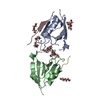 8b87C 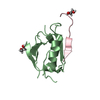 8b8oC 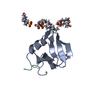 8b9tC 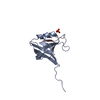 8biaC 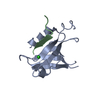 8bj0C 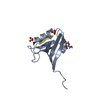 6mtvS S: Starting model for refinement C: citing same article ( |
|---|---|
| Similar structure data | Similarity search - Function & homology  F&H Search F&H Search |
- Links
Links
- Assembly
Assembly
| Deposited unit | 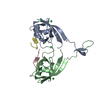
| ||||||||||||
|---|---|---|---|---|---|---|---|---|---|---|---|---|---|
| 1 |
| ||||||||||||
| Unit cell |
|
- Components
Components
| #1: Protein | Mass: 12293.823 Da / Num. of mol.: 2 Source method: isolated from a genetically manipulated source Source: (gene. exp.)  Homo sapiens (human) / Gene: SCRIB, CRIB1, KIAA0147, LAP4, SCRB1, VARTUL / Production host: Homo sapiens (human) / Gene: SCRIB, CRIB1, KIAA0147, LAP4, SCRB1, VARTUL / Production host:  #2: Protein/peptide | Mass: 1345.554 Da / Num. of mol.: 2 / Source method: obtained synthetically / Source: (synth.)  Human papillomavirus type 18 / References: UniProt: P06463 Human papillomavirus type 18 / References: UniProt: P06463#3: Chemical | ChemComp-CL / #4: Water | ChemComp-HOH / | Has ligand of interest | N | |
|---|
-Experimental details
-Experiment
| Experiment | Method:  X-RAY DIFFRACTION / Number of used crystals: 1 X-RAY DIFFRACTION / Number of used crystals: 1 |
|---|
- Sample preparation
Sample preparation
| Crystal | Density Matthews: 2.14 Å3/Da / Density % sol: 42.47 % / Description: Rod |
|---|---|
| Crystal grow | Temperature: 293.15 K / Method: vapor diffusion, sitting drop / pH: 8 / Details: 15% PEG 4000, 0.05 M Ammonium Sulfate / PH range: 8 / Temp details: 293.15 |
-Data collection
| Diffraction | Mean temperature: 100 K / Serial crystal experiment: N |
|---|---|
| Diffraction source | Source:  SYNCHROTRON / Site: SYNCHROTRON / Site:  Australian Synchrotron Australian Synchrotron  / Beamline: MX2 / Wavelength: 0.95372 Å / Beamline: MX2 / Wavelength: 0.95372 Å |
| Detector | Type: DECTRIS EIGER X 16M / Detector: PIXEL / Date: Oct 23, 2020 |
| Radiation | Protocol: SINGLE WAVELENGTH / Monochromatic (M) / Laue (L): M / Scattering type: x-ray |
| Radiation wavelength | Wavelength: 0.95372 Å / Relative weight: 1 |
| Reflection | Resolution: 2.8→49.74 Å / Num. obs: 5671 / % possible obs: 99.23 % / Redundancy: 12.7 % / Biso Wilson estimate: 47.35 Å2 / CC1/2: 0.997 / Rmerge(I) obs: 0.1381 / Net I/σ(I): 12.18 |
| Reflection shell | Resolution: 2.8→2.9 Å / Rmerge(I) obs: 0.5239 / Num. unique obs: 560 / CC1/2: 0.964 |
- Processing
Processing
| Software |
| ||||||||||||||||||||||||||||||||||||||||
|---|---|---|---|---|---|---|---|---|---|---|---|---|---|---|---|---|---|---|---|---|---|---|---|---|---|---|---|---|---|---|---|---|---|---|---|---|---|---|---|---|---|
| Refinement | Method to determine structure:  MOLECULAR REPLACEMENT MOLECULAR REPLACEMENTStarting model: 6MTV Resolution: 2.8→49.74 Å / SU ML: 0.3488 / Cross valid method: FREE R-VALUE / σ(F): 1.34 / Phase error: 21.121 Stereochemistry target values: GeoStd + Monomer Library + CDL v1.2
| ||||||||||||||||||||||||||||||||||||||||
| Solvent computation | Shrinkage radii: 0.9 Å / VDW probe radii: 1.11 Å / Solvent model: FLAT BULK SOLVENT MODEL | ||||||||||||||||||||||||||||||||||||||||
| Displacement parameters | Biso mean: 46.31 Å2 | ||||||||||||||||||||||||||||||||||||||||
| Refinement step | Cycle: LAST / Resolution: 2.8→49.74 Å
| ||||||||||||||||||||||||||||||||||||||||
| Refine LS restraints |
| ||||||||||||||||||||||||||||||||||||||||
| LS refinement shell |
| ||||||||||||||||||||||||||||||||||||||||
| Refinement TLS params. | Method: refined / Origin x: -13.3072185206 Å / Origin y: 17.2103366331 Å / Origin z: -15.7530182633 Å
| ||||||||||||||||||||||||||||||||||||||||
| Refinement TLS group | Selection details: all |
 Movie
Movie Controller
Controller


 PDBj
PDBj












